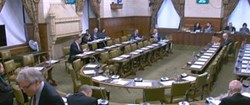Sign up to the
Share Radio Newsletter
Stay up to date with our latest programmes, weekly comment and podcasts.
‘The difference between a politician and a statesman is that a politician thinks about the next election while the statesman thinks about the next generation’
James Freeman Clarke, American theologian and author (1810-1888)
The BBC's 2025 Reith lectures are entitled ‘Moral Revolution’, and they are being delivered by Rutger Bregman. The title is a worthy aspiration, but almost everything that's happened during this past year has made bringing about a moral revolution feel like pushing water uphill.
The three major threats for our time have all grown massively:
The arrival of the Trump Mark 2 presidency has graphically exposed all of these growing risks. His actions have, in my view, raised the threat level in all three respects — including the risk of conflict, where he regards himself as a peacemaker. However, he is by no means the only person bearing responsibility in that respect..
..........
We've published 430 of these weekly commentaries covering a wide range of issues, and you can find links here to the full list over the past eight years.
The impact of the Budget continues to be found in The Bigger Picture, a bonus episode from This Is Money and The Financial Outlook; meanwhile, This Is Money’s main episode looks at public service pensions. Motley Fool Money considers the Netflix takeover of Warner Brothers, and the outlook for an IPO of Anthropic. There’s a Modern Mindset on gold, an episode of The Hypnotist on how to bring love and passion into your Christmas cheer. Plus, there are our regular reviews of the latest gadgets and movies — and please note that for quick links to Gadgets & Gizmos podcasts via Spotify, Apple, and Amazon, just click here:
Please scroll down this home page for links to these programmes. Also, for those who prefer listening on Apple, Spotify or Amazon, try searching for our podcasts under ‘Hrkn’ — a quick way to find us!
It's great to see Simon Rose, presenter of The Bigger Picture, The Financial Outlook, Gadgets & Gizmos and The Business of Film recognised in the Radio Times!
Also — please consider joining the Classic Movie Club where James Cameron-Wilson, Simon's sparring partner in The Business of Film, is executive editor.
Our 'live stream' is also now available on Alexa: just say 'Alexa, enable Share Radio skill', then 'Alexa, play Share Radio' or 'Alexa, open Share Radio' when you want to listen.
If we are to establish a more equitable society — supporting the individual human achievement so vital for democratic capitalism, but at the same time based on egalitarian principles — it is also vital to provide the necessary academic rigour to support its propositions.
King’s College, Cambridge, in partnership with the University's Faculty of Economics, has established the SHARE research project (Supporting Human Achievement through Research based on Egalitarian Principles) with a four-year post-doctoral research fellowship. Areas of research include inter-generational wealth transfer; human capital (improving inequality and productivity through education and training); disintermediation; and mass ownership.
Share Alliance is being established as a registered charity to support and provide oversight for the research project.
On Friday 14th April '23 its first half-day conference took place, concentrating on two leading propositions: inter-generational rebalancing and 'Stock for Data'. It was also an opportunity to hear about underlying principles and its planning for the future, and there was a panel session for general discussion.
Video recordings of all five sessions are available via the Share Alliance website. Presentation slides are also available here.
When you just need some relaxing background music for reading, writing or entertaining, Share Music complements our speech programmes with a flow of instrumental folk music. However these speech programmes are always at hand via Share Sounds, where there's also an online slide display to highlight some of the best.
Information on tracks played is shown both on the 'Listen Live' tab and on our mobile app: but please note one of our latest additions: 'Resonant Futures' by The Imaginaries.

Here's your 100% internet Ocean Digital WR-220 radio, pre-set for Share Radio!
Plus - access to over 15,000 more radio stations across the world.
Competitively priced at -
£69 + £5 post/packing (UK delivery)
Please register via The Share Foundation for free access to Share Radio, as either our live stream or to our substantial podcast library.
After you first enter your email address and have activated it with your PIN code, you shouldn't have to enter it again - as your computer or mobile device will remember that you've signed up.
In partnership with publishers Harriman House, Share Radio has produced the audiobook 'Superinvestors', written by Matthew Partridge and read by some of Share Radio's best known presenters: Simon Rose, Fenella Fudge, Glen Thompsett, Ed Bowsher and accomplished actor David Ricardo Pearce, whose ancestor is featured in the book.

Welcome to Gavin Oldham's full presentation describing his vision for egalitarian capitalism.
The main set of proposals are as follows:
Egalitarian Capitalism is an alternative to socialism which, while fostering and encouraging enterprise for all, acts to involve and empower people right across society and especially the young.

Few would disagree with St. John's conclusion that the nature of our conscious creator — of God — is love. In the Christian faith, it's at the heart of the two great commandments and inspires the whole amazing journey against all odds. But the word is totally absent from the Nicene Creed, repeated each Sunday in Churches. Christmas is the time to celebrate love in all its many splendours, but particularly to share love with children and young people. Let's hope that strategies announced by the UK Government over the last few days for children and young people are just the beginning, in terms of showing love for the generations who will follow us. Background music: 'Carol of the Bells' by Quincas Moreira
MORE
Labour MPs' celebration of the Chancellor's abolition of the 2-child welfare benefit cap in last week's Budget statement completely eclipsed the outstanding need for a comprehensive strategy to address the economic and familial stresses impacting children, adolescents and young adults: so much worse than a few decades ago. We focus on three specifics in this commentary: the continuing denial of Government to deliver Child Trust Fund money to low-income young adults unaware of their money; the punishing burden of the student loan system, and the instability and insecurity caused by a society which has lost its moral compass. Background music: 'Generations Away' by Unicorn Heads
MORE
This commentary takes stock of all things 'Share' as at Autumn 2025. The Share Foundation has made substantial progress: it's enabled over 100,000 young people to claim nearly £¼ billion of Child Trust Funds, and the relatively modest £200 central government grant for opening Junior ISAs for young people in care is enabling substantial local contributions to be raised, accompanied by significant reductions in welfare benefit costs as a result of reduced NEET rates. Meanwhile, Share Alliance's quest for a more egalitarian form of capitalism is steadily building momentum. This is particularly so with research into the potential issuance of equity shares in return for tech businesses which are harvesting our data and creativity while significantly reducing employment opportunities, particularly for young people. Background music: 'Hopeful Freedom' by Asher Fulero
MORE
Professor Tim Evans adds his voice to those opposing the restriction to trial by jury. It is an ancient right to be judged by one's peers, a democratic safeguard of liberty against an overbearing state. He feels it will lead to a loss of public confidence and democratic illegitimacy of the legal system. Without the rule of law, you don't have trust and without trust you don't have an economy. The government need to find other ways to reduce the legal backlog. While the Chancellor and her advisers appear not to have worked out exactly how EV users will be charged per mile they drive, Tim wonders if she realises that the idea is a darling of the libertarian right, proposed by Milton Friedman back in the early 1950s. it is, in essence, returning to the Georgian era of turnpikes. He feels, though, that it will create an incentive to keep roads in a good state. The era of all roads being "The King's Highway" can no longer be afforded.
MORE
Steve Caplin says it's been a bad week for Elon Musk. X has been fined €120m for breaching EU digital laws, his Optimus robot demo was disastrous and X's new location facility may help Iranian authorities identify dissenters. He discusses the researchers hoping to make robot hands from lobster shells, the glasses that change focus automatically, a crowd-funding project redesigning a loose-leaf teapot, a printer for children's drawing ideas, an LED light from Ikea and a biodegradable coffin made of mushrooms. He also strongly recommends https://everythingiknow.online, his own new website.
MORE
James Cameron-Wilson says that box office, despite a WoW drop of 17%, is still very healthy. #5 ‘Eternity’ depicts an afterlife where souls must pick their preferred eternity. Although a comic parable where a woman must choose with which man to spend the afterlife, it fails to work on several levels. James, disappointed by the ending, was not moved. He found the Blu-Ray release of 1954's ‘Apache’, directed by Robert Aldrich and starring Burt Lancaster, to be a fascinating insight into attitudes of the time. Although at the forefront of those films more sympathetically depicting Native Americans, Lancaster is an unpleasant and hugely misogynistic character while the movie is highly patronising by current standards. He was much keener on Netflix's ‘Jay Kelly’, Noah Baumbach's film of a film actor not hugely dissimilar to George Clooney, played by George Clooney, only more unpleasant and egotistical. It has many wonderful scenes, it should resonate with many and James loved it.
MORE
Mortgage lenders are battling to offer borrowers lower rates - running ahead of the Bank of England making an expected cut next week. That's good news for anyone buying a home but it's even better for the 1.9million people who need to remortgage next year, many of whom will be facing a payment shock as they come off much lower fixed rates. Will the mortgage cuts revive the moribund housing market — and what should you do if your fixed rate is running out? Georgie Frost, Helen Crane and Simon Lambert talk mortgages and the property market - including why experts say now is the best time in a decade to negotiate on a new build home. Plus, what does the Fed rate cut mean for investors, would you give a child or grandchild shares for Christmas, and finally, where are Britons trying to buy homes abroad — and why?
MORE
Finlay Mathers of Edison discusses BP, which has changed strategy to give an emphasis to shareholder return, increasing investment in oil & gas by 20% while reducing transition investment by 70%. The company will be focussing on cost reductions and efficiency, strengthening its balance sheet and reducing net debt. Neil Shah of Edison returns to the topic of Games Workshop, which he has mentioned here before on more than one occasion. This one-time small company has now entered the FTSE and the shares are up 40% this year. It's an exceptionally well-run business and its Warhammer figurines will become even better known when the Amazon TV series approaches production. It has a very progressive dividend and, while it is on a PE of 30, it is a niche business that should keep growing at pace.
MORE
Disney agreed to let its characters be used in OpenAI’s Sora videos, so is this a visionary move, or is Disney giving away its IP to AI? We discuss media in AI, Oracle’s recent earnings report, and ask what executive would be the dream-free agent pickup for some beaten-up stocks. Travis Hoium, Dan Caplinger, and Jon Quast discuss Disney’s licensing deal with OpenAI, Oracle’s earnings and AI buildout, Lululemon earnings recap, and CEO free agent picks. Companies discussed: Nike (NKE), The Trade Desk (TTD), Disney (DIS), Block (XYZ), Oracle (ORCL), Alphabet (GOOG). Host — Travis Hoium; Guests — Dan Caplinger, Jon Quast.
MORE
2025 has been an above-average year for stocks. And over 300 publicly-traded companies have increased in value by 100% or more. This has our team asking the question: Which of these upward moves are legit and which could be doomed to revert back in 2026? This episode features discussions on energy, technology, real estate, and more. And our analysts aren't in perfect agreement on the outlook for these stocks in the coming year. Tyler Crowe, Matt Frankel and Jon Quast discuss solar energy and nuclear energy, quantum computing and AI trends, a real estate meme stock, and stocks on our radar. Companies discussed: LMND, MU, NXT, OPEN, QBTS, OKLO, EME, DIS, MELI. Host — Tyler Crowe; Guests — Matt Frankel, Jon Quast.
MORE
Inception Island is a rather special island in a rather special Canadian lake; Adam uses this analogy to help you to create a wonderful feeling of positive relaxatin — just what's needed for Christmas time. Inception islands are also known as recursive islands: try this YouTube video
MORE
The dust has settled on the Budget but while we now know what Rachel Reeves plans for our finances, many questions remain. The Budget featured a raft of tax rises — but also left out some moves that were widely rumoured to happen. On this special bonus episode, Simon Lambert is joined by Lisa Caplan, of Charles Stanley Direct, to find out what people are asking after the Budget — and the answers to those important questions
MORE
A new survey suggests rising costs are changing how people think about money and value. More than two in five say gold is the Christmas gift most likely to hold its value, while four in five say Christmas dinner costs more than last year and nearly two-thirds fear another financial crisis.
And, in a lighter twist, Scrooge has beaten the Three Wise Men as the Christmas character most likely to invest in gold. Joining Rory McGowan to discuss this is Precious Metal Experts David Russell.

The UK Budget speech and the response from Leader of the Opposition Kemi Badenoch. This includes the 'Point of Order' beforehand from Mel Stride regarding the premature release of the OBR report. This is the unabridged record without comment, and the recording runs for one hour and 31 minutes.
MORE
Inheritance tax has long been one of Britain’s most unpopular levies - and research shows why it’s becoming an even greater concern. Rising property prices, frozen tax thresholds, and upcoming changes to reliefs mean more ordinary families are at risk of being caught in the net. At the same time, many people admit they are financially dependent on inheritance, making the stakes higher than ever. Joining Rory McGowan to discuss this is inheritance tax expert and CEO and Founder of Level Group, George Williamson.
MORE
Pensions and inheritance are at the forefront of many people's minds ahead of the Budget. In her last Budget, Rachel Reeves announced she will pull pension pots into the inheritance tax net from April 2027. Meanwhile, there are concerns that pension tax-free lump sums and inheritance tax allowances could fall victim to another raid as the Chancellor tries to balance the books again. In this special episode of the This is Money podcast, Simon Lambert is joined by Lisa Caplan, director of Charles Stanley Direct Advice and Guidance. Lisa spends her days helping customers understand how to protect their wealth, make their pension last in retirement and, importantly, enjoy their hard-earned money. She discusses with Simon the questions people are asking right now about pensions and inheritance tax and her answers.
MORE
Rory McGowan speaks with James Kaberry, a non-executive director at IO Finance Partners, about the current state of SMEs in the UK. They discuss the significant role SMEs play in the economy, the challenges they face in accessing capital, and the rise of alternative lending solutions. James emphasises the importance of supporting SMEs to foster growth and stability in the economy, while also providing practical advice for those struggling to navigate the current financial landscape. https://iofp.co.uk/
MORE
The world is facing a myriad of Gordian Knots at present — problems so intricate and complex that they need new and very different approaches to solve them. In Greek mythology, it was Alexander the Great who chopped the knot rather than struggling to untie it. If you're facing a raft of complex problems, this episode could help you find novel and creative ways to solve them. So, think of the most challenging things in your life and listen in for inspiration. Maybe Donald Trump should seek Adam Cox's guidance for resolving conflicts across the world, or the UN for dealing with climate change — or Governments across western democracies seeking an answer for intractable debt problems? Image: Wikipedia
LISTEN HERE
The unabridged recording of Rachel Reeves’ speech in the House of Commons on 11th June 2025.
MORE
For the 500th show, Steve Caplin takes a look back at some of the highlights of ten years of Gadgets & Gizmos. He covers sprayable sleep, cows imitating zebras to ward off mosquitoes, crows collecting cigarette butts, NFTs, self-parking slippers, KFC chicken-tasting nail polish, the first human head transplant, the Skunklock noxious bike lock, Refrigerdating, the robot dog flamethrower, ant populated gin and how to make pain relief pills 10 times more effective.
MORE
Berkshire’s cash hoard is approaching “Dr. Evil” levels. Tim Beyers and Dylan Lewis discuss Warren Buffett’s message to investors and Berkshire Hathaway shareholders in his annual letter, Berkshire’s growing cash position and what it might say about his view of the investing opportunities out there, and Apple’s $500Bn commitment to its Advanced Manufacturing Fund, AI development, and R&D efforts. Then, 16 minutes in, American's pharmaceutical options for legally treating mental health issues could expand soon. MindMed is testing the effects of LSD on depression and Anxiety, the company’s CEO Rob Barrow talks Ricky Mulvey through his company's work and the future of psychedelics and mental health. Companies discussed: BRK.A, BRK.B, AAPL, MNMD. Host - Dylan Lewis; Guests - Tim Beyers, Rob Barrow, Ricky Mulvey
MORE
James Cameron-Wilson reports on box office -13% but still up on 2024, with ‘Wicked’ becoming last year's most successful film with £59.6m. The musical biopic of Bob Dylan, ‘A Complete Unknown’, with Timothy Chalomet and Edward Norton is the new #1. The tedious and unbelievable ‘Wolf Man’ limps in at #7. James found Netflix's spy thriller ‘Back in Action’, the return from retirement of Cameron Diaz, all very silly and over the top, despite some good stunts. The Oscar nominations were coming out during recording, so James gives his first thoughts on who's in and who's out.
LISTEN HERE
Warren Buffett sends us into the season to be thankful with his philanthropic acts and his poignant words, and gives us all a place to start the conversation with family about money. Asit Sharma and Dylan Lewis discuss NBC’s negotiations to extend their rights to broadcast rights to the Macy’s Day Parade, and why holiday live events are turning into an arms race, the expectations for Black Friday through Cyber Monday, and two predictions on the direction of consumer spend and who will be driving it in future years, and Warren Buffett’s plans for passing his wealth on to his family and philanthropic efforts, and the words of wisdom we should all have in mind as we get together with loved ones this week. Companies discussed: CMCSA, M, NFLX, AMZN, BRK.A, BRK.B. Host - Dylan Lewis; Guests - Asit Sharma
MORE
The State Opening of Parliament on Wednesday 17th July was somewhat of a watershed after fourteen years of Conservative governments. Here is the unabridged King's Speech, encapsulating in just over twelve minutes the priorities of the new Labour Government. Image Source: Daily Express. Background music following the speech: 'Pastorale' by Joel Cummins
MORE
The core of the problem with unclaimed, adult-owned Child Trust Funds (of which there are over £2 billion waiting to be claimed) is with accounts opened by HMRC. That's why The Share Foundation has proposed a 'default withdrawal at 21' process, based on the young person's National Insurance number. Danny Kruger MP took part in the CTF conference in Westminster on Tuesday 5th March, and two weeks later in a Westminster Hall CTF debate, and supported this initiative which could release £1/4 billion each year to help these young and predominantly low-income young adults. Background music: 'Waiting' by Andrew Langdon

The debate on 19th March 2024 was hosted by Sir Jeremy Quin MP to call for the need to simplify family access to Child Trust Funds for disabled young people, and a number of MPs contributed to the debate, including Danny Kruger and Ed Davy. The audio record is provided by Parliament Live, and is an unabridged recording of proceedings, without additional comment. Listeners may notice an adjournment for voting in the House of Commons.
MORE
Adam Cox is joined by Gemma Bourne from Big Society Capital to discuss why the government should reallocate a larger proportion of its existing spend to further scale initiatives that tackle the UK's homelessness and temporary accommodation crisis. With new research showing that these house funds are already having a major impact, it could help us combat homelessness. https://bigsocietycapital.com/
MORE
Professor Tim Evans of Middlesex University explains why he so enjoyed new Argentine President Javier Milei lecturing the great and good of the World Economic Forum about libertarian and Austrian economics, attacking corporatism and socialism. He feels Milei could be the most consequential politician economically-speaking for many years. He also looks at falling EV car sales, lamenting the way in which politicians set goals for achieving their hobbyhorses irrespective of scientific progress and consumer demand. And he is fascinated by a meeting between journalist John Humphreys and members of Gen Z, which showed them to be different to the popular perception.
MORE
Welcome to a special episode of The Financial Outlook: the investment section of the Managing My Money course. What's the difference between saving and investment? It's all in the risk. We talk about shares, bonds and funds, and which perform best over the long term. The Managing My Money course has 16 sections in total, and is presented by Glen Goodman and Annie Weston. You can enjoy the whole course, produced in association with the Open University via Share Radio's home page. Here's the link to the slides for this episode: https://www.shareradio.co.uk/help-guides/managing-my-money/supporting-slides/mmm-week-5-episode-10-supporting-slides/
MORE
“The [Child Trust Fund] scheme has been closed to new entrants for over 12 years. In this time HMRC has been focusing resources on evaluating and improving existing schemes. We will continue to keep the need to evaluate old schemes under review.” So said Andrew Griffith MP, Economic Secretary to HM Treasury in reply to a parliamentary question from John Ashworth MP, Shadow Secretary of State for Work and Pensions. But this is not an 'old scheme' — there is currently over £1.7 billion sitting in mature accounts belonging to over 900,000 mainly low-income young adults throughout the UK who don't know anything about their good fortune! Their Child Trust Fund harvest is seeing too little action at present: but it's not too late to get it sorted, and the current focus from the National Audit Office and Public Accounts Committee will certainly help.
Background music: 'Hopeful Freedom' by Asher Fulero

The huge take-up of ChatGPT over recent weeks has brought the challenge of Artificial Intelligence into sharp relief. As the Chief Executive of its creator, OpenAI, said in one of his blogs, 'Artificial Intelligence will bring unimaginable wealth but, unless something changes, most of us will get none of it. We need a radical solution'. Conventional wisdom sees Universal Basic Income as the way through this dilemma, but this will only bring us more state intermediation and human subservience. We can put forward a better solution, by enabling all to share in the wealth that technology brings and to play their part in its future governance.
Background music: 'Digital Solitude' by Silent Partner

Jonathan Davis, editor of the Investment Trusts Handbook, tells Simon Rose what makes investment trusts special and why investors should consider their merits. He explains the differences to other types of funds, including the premium and discount. He discusses the yields on alternative assets (including renewable energy and even music royalties) and how trusts can continue paying dividends even in bad years. The handbook, from Harriman House, is available in hardbook or free as an ebook (https://tinyurl.com/mt69fc24).
MORE
It’s the last episode of Answers (but don’t worry, we’re just moving to Motley Fool Money every Tuesday). We’ll reminisce on our biggest lessons learned over the last seven years and answer your questions, some financial, some festive.
MORE

The Talk by the WealthiHer Network, every month on Share Radio: this month we are here to talk about the secrets of some of UK leading female businesses leaders and their journeys within launching their businesses. Tamara Gillan is joined by Charlotte Bobroff, the executive director at J.P. Morgan who has been incremental with working with female founders from female high-powered businesses. She recently curated an event surrounding female high-powered businesses and she will be discussing her findings. Also, we have the pleasure of Daina Speddings, who is an investor at BGF and will share her perspective on the investment journey.
MORE
Scrooge has made the deal of his life with Chinese investors and must now quickly return to London on Christmas Eve to close the deal. On the flight back, during a fitful sleep, Scrooge confronts his past and present and learns the future consequences of his miserly life to find the true meaning of Christmas. Proscenium Online Theatre is super excited to be bringing you a whole new season of audio dramas in 2022. Starting off with 'The Girl in the Yellow Dress', a dark romance by South African playwright Craig Higginson, and 'Plunder', an original Hong Kong based thriller by American playwright Alan Olejniczak. In the meantime - sit back, close your eyes and enjoy the Proscenium Online Theatre’s production of 'A Christmas Carol'.
https://www.prosceniumonlinetheatre.com
MORE

Join the Sustain:Social panel session on December '21, considering the outlook for investors in the wake of the COP26 in Glasgow. The panel comprises of - Chair: Rodney Hobson Panel: Gervais Williams (Premier Miton Group); Jamie Broderick (Impact Investing Institute); Mohan Gundu (Sustainable Funds Group); Mike Appleby (Liontrust Sustainable Investment team); Gavin Oldham (The Share Foundation / Share Radio).
MORE
Food banks are providing a vital role to help people this winter, and the Trussell Trust supports more than 1,200 throughout the United Kingdom. In this special episode of The Bigger Picture, their Chief Executive Emma Revie briefs supporters about their progress, and their plans for the future. If you would like to support the extraordinary work undertaken by this charity, please visit https://trusselltrust.org
MORE
Imagine a world in which everyone has a stake in the great tech firms that serve them each day, and where dividends are gradually replacing wages to provide regular income for everyone, as work becomes scarcer as a result of automation? Imagine a world where every young person not only has a small inheritance with which to start their adult life, but also the opportunity to build its value by learning life skills? Simon Rose is taking a well-earned break this week, so we’re taking the opportunity to bring you a talk given Gavin Oldham in August to the leading City of London think-tank Z/Yen.
Click link for slides for presentation
LISTEN HERE

Every child in the UK born between 1 Sept 2002 and 2 Jan 2011 has a Child Trust Fund (CTF). But one child in six has lost contact with the money. Gavin Oldham, Chairman of The Share Foundation – which runs the Junior ISA & Child Trust Fund schemes for children in care for the Department for Education - is trying to re-connect them. He talks through the CTF, how to track an account down, and what a child can and can’t do with the money.
MORE
In a new partnership with publishers Harriman House, Share Radio has produced its first audiobook 'Superinvestors', written by Matthew Partridge and read by some of Share Radio's best known presenters. 'Superinvestors' lays bare the investing secrets of legendary investors - from early 20th-century figures such as Benjamin Graham and John Maynard Keynes, through to more modern names such as Anthony Bolton and Warren Buffett.
LISTEN HERE
How you can help young people in care prepare for adult life by supporting The Share Foundation’s ‘Stepladder of Achievement’ programme.
LISTEN HERE
Reserve your 100% Internet Radio, pre-set with both Share Radio and Share Music channels!
Access over 15,000 more radio stations across the world!
We'll soon be supplying very competitively priced 100% online radios: be one of the first to get one.